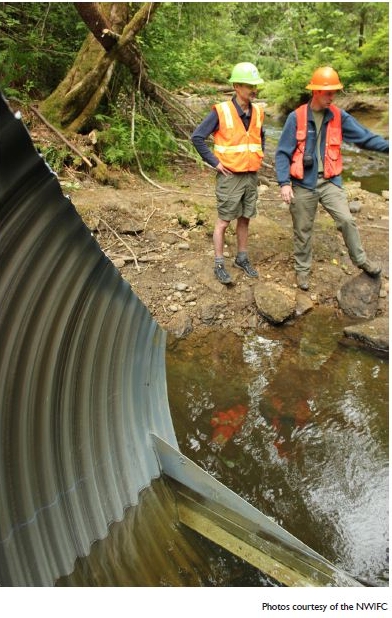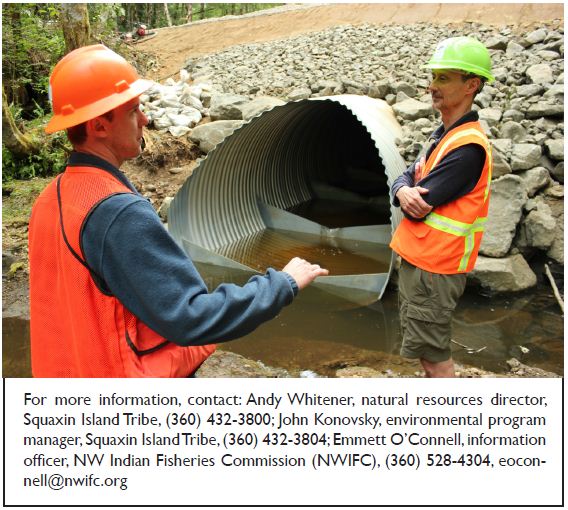Midway Creek HabitatBy NW Indian Fisheries Commission
The culverts blocked Midway Creek, a tributary to Goldsborough Creek and ran underneath a railroad owned by Simpson Lumber, which is contributing significant funding to the project. The Green Diamond Resource, a sister company to Simpson, is also provided important support to the project. "Midway Creek is relatively undisturbed, so fish will be able to use excellent habitat when we're done," said Sarah Zaniewski, a salmon biologist with the tribe. The enhancement group and the tribe replaced two undersized culverts with one 14-foot-wide culvert that will provide a more natural stream channel. "In addition to some great spawning habitat, the fish that make it up Midway Creek will also have access to deep rearing pools and wetlands," said Brian Combs, biologist for the enhancement group. Culverts like the one that block Midway Creek are not rare. "There are thousands of culverts like this one throughout Puget Sound," Zaniewski said. "They block a lot of salmon habitat throughout the region. Salmon need that habitat to thrive." The work to open salmon access to Midway Creek builds on an effort more than a decade ago to bring down a dam on lower Goldsborough Creek. "After the dam came down, salmon were able to access the upper 25 miles of the Goldsborough Creek watershed," Zaniewski said. "Freeing Midway Creek will give salmon even more habitat to use." Coho will especially benefit from the restoration project, since they spend more time in freshwater than other salmon species and depend more on freshwater habitat. Over the past 20 years, deep South Sound coho production has been on a slow but steady decline.
"The tribe's treaty reserved rights to harvest salmon depend on there being healthy stocks of salmon," said Andy Whitener, natural resources director for the tribe. "Creeks with no salmon mean we've lost something central to our culture and economy. We need to bring back more places like Midway Creek to make sure our way of life survives." For more information, contact: Andy Whitener, natural resources director, Squaxin Island Tribe, (360) 432-3800; John Konovsky, environmental program manager, Squaxin Island Tribe, (360) 432-3804; Emmett O'Connell, information officer, NW Indian Fisheries Commission (NWIFC), (360) 528-4304, eoconnell@nwifc.org
Back to Home page. |

 The Squaxin Island Tribe joined the South Puget Sound Salmon Enhancement Group, Simpson Lumber and the Green Diamond Resource Company to open almost a mile of salmon habitat by removing two fish-blocking culverts.
The Squaxin Island Tribe joined the South Puget Sound Salmon Enhancement Group, Simpson Lumber and the Green Diamond Resource Company to open almost a mile of salmon habitat by removing two fish-blocking culverts.
 "This project is a great example of what we can do to increase access to suitable fish habitat," Combs said.
"This project is a great example of what we can do to increase access to suitable fish habitat," Combs said.